
1. Triple Meeting with an Elephant
Brooklyn Bridge – New York, a building for which several personalities have contributed, some of whom have remained heroes. The project was carried out by John Augustus Roebling, who was injured during the construction, eventually killing his life. Roebling crushed his right foot during a river maneuver near the bridge. Wound infected and died. Washington Roebling – his son – took over the work, but after a while he fell ill because of his visits to the legs of the bridge (compression / decompression phenomenon). He followed the inauguration of the bridge in a room in the city. The honor to finish the bridge was returned to the wife, who, without engineering knowledge, had done the job. He was the first to cross the bridge.
.
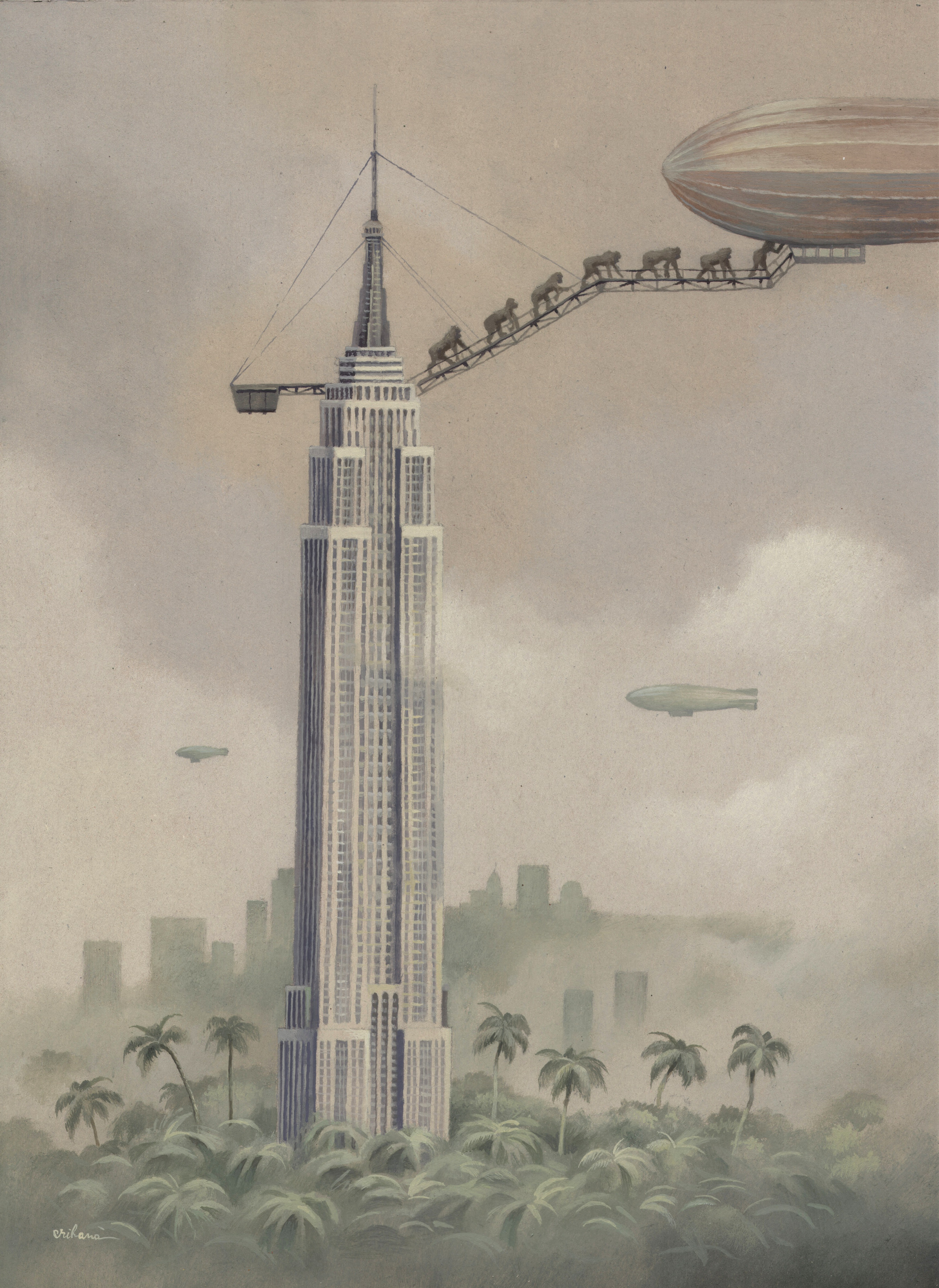
2. Zeppelin station at Empire State Building
The top of the Empire State building was thought of as an anchor point for the zeppelins. It was a technical naivety, especially because the other part of the zeppelin was free in the wind. Landing would be very dangerous. Still, there was an imaginary character who would have had the courage for boarding: King Kong. As a result of monkeys traffic, a jungle emerged at the base of the building.
.

3. Ships
As part of the immigration reception mechanism, Castle Garden has played an important role. It was the Immigration Reception Station. At first it was a city defense construction against the British (1812). It was also a cultural and theater center.
.

4. Penn Station
Pennsylvania Rail Station is New York’s main railway station. It came up with the modernization of locomotives and tunnel construction (under the Hudson River). Located in Manhattan, it was built between 1901 and 1910. It was Gare d’Orsay Paris. After a decline in use, it was decided to demolish the building and rebuilt between 1963-1969. The demolition was accompanied by street protests, and the New York Times wrote: “The city receives what it wants, what it is capable of paying, and finally what it deserves.” “Until the first wall fell, no one thought Penn Station would be really demolished, or that New York would allow this monumental act of vandalism against the largest and most beautiful edifice of Roman elegance. ” Penn Station is today entirely under Madison Square Garden – the famous American arena
.

5. Singer Building (currently involved in an event)
“An architectural giraffe ” – The New York Globe, “A bulbous mansard and giant lantern at the peak” – The New York Times. These were the ironic titles with which the American press witnessed the appearance of the Singer Building in New York. Singer Building or Singer Tower was erected in 1908 by the Singer Sewing Machine Company. It had 47 floors. Between 1908 and 1909 he held the world record. Architect Ernest Flagg – an exponent of the Beaux-Arts style, was committed to the project. In 1961, Singer Manufacturind Company sold the building and moved to the Rockefeller Center. The building did not receive the landmark certificate so the new owner ordered hits demolition and replacement with a new one. The new building had up to 10 times more space on the floor. The floors of the Singer tower had become too narrow for the ambitions of modern New York. New York Times wrote: ““Daring in ’08, Obscure in ’68.” The Singer building was beautifully decorated in terracotta, red brick, colored stone. It was the tallest building in the world subjected to the willful demolition. It was the world’s tallest building, a record beaten by the tragedy of the Twin Towers – World Trade Center in 2001. The interior was decorated with a forest of marble columns that wore the company emblem. After demolition all the decorations were sold.
.
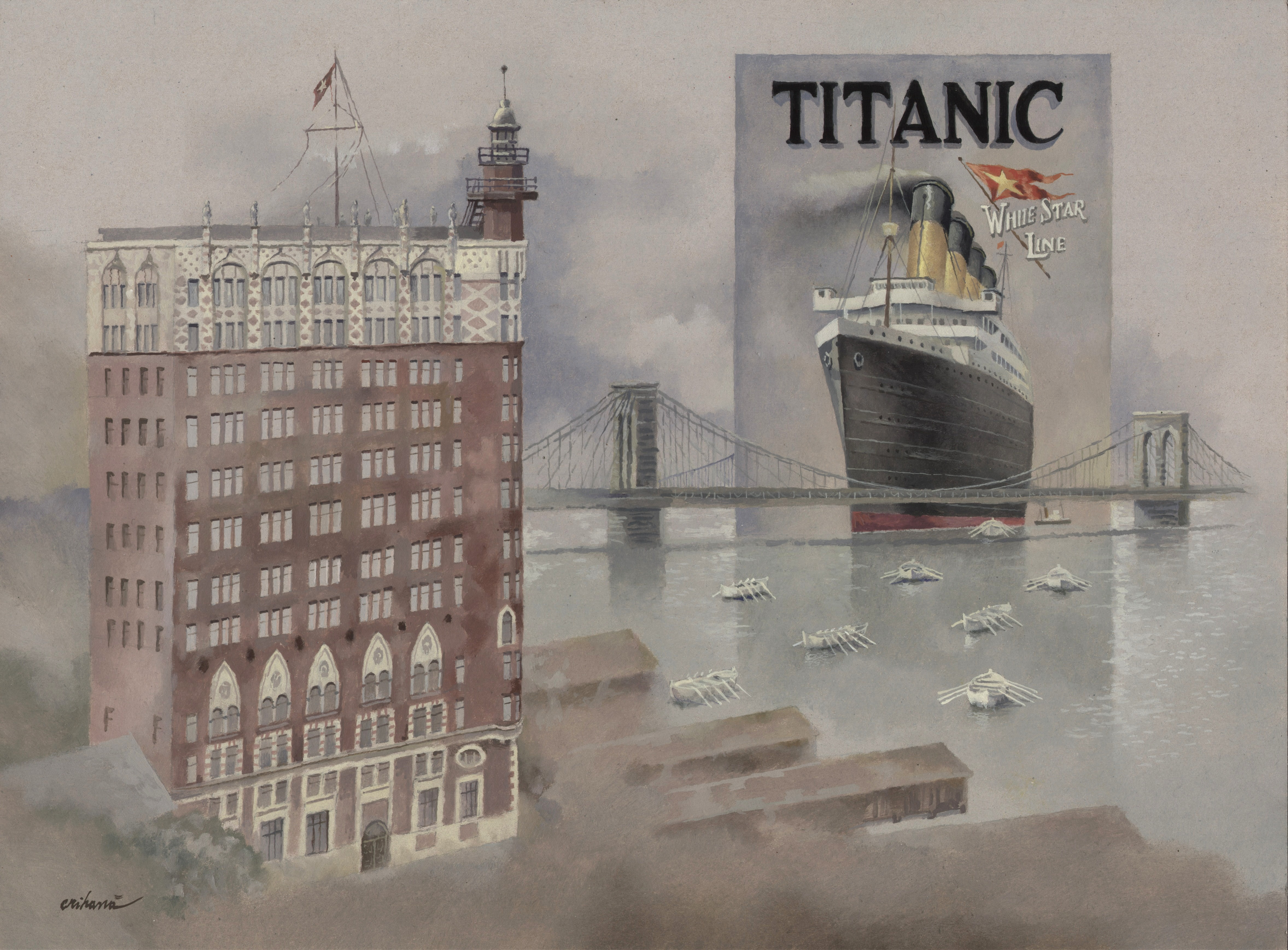
A pleasant surprise for me: the revelation of New York’s tribute to the victims of the Titanic ship’s wreck. Titanic is a topic I’ve been studying for a year. There are always new things to discover. Near the Brooklyn Bridge was the Seaman’s Church Institute; on this building was built by public subscription a lighthouse and a mast – two symbols as homage to the victims of Titanic. While I was representing the building in detail – there were not many pictures left with it – I felt I had to deal with the Doge Palace of Venice; that because of the similar decorations. The building no longer exists, but the lighthouse remained – lost somewhere on a street.
.

7. Clock Tower
Campanile di Piazza San Marco, Venezia – this was the model after which the Americans built the Clock Tower. The building is in the vicinity of Madison Square Park, very close to the Flatiron building. For four years it was the tallest building in the world. The tower has 41 floors, and the clock has quadrants on all four sides of the tower, being among the largest in the world.
.

8. Empire State Building Lobby
The two entrances to the building are dominated by stainless steel shapes. The lobby has three levels. On the ground floor there is an aluminum fresco in which the building is represented. The first 85 floors of the building are occupied by various institutions, and the 16 upper levels remain the art-deco Tower. The last level is Observatory Deck; for a long time the railing was endowed with threatening sewers against suicides.
.

9. Carnegie Hall Chandelier (in administration by Artios Gallery, New York)
Carnegie Hall was built by Andrew Carnegie in 1891 for the Oratorio Society of New York and the New York Symphony Society. Architect William Burnet Tuthill was commissioned to do the project and went to Europe to document himself. The acoustics of the room came out of a very good quality, but the appearance was a new one compared to those seen in Europe. However, the audience wanted a chandelier in the main hall and my work refers to this aspect, to call it “romantic”. The balconies were also missing. Carnegie Hall Tower was built in 1991, bringing the theater to the overall look of the 60-story skyscraper.
.
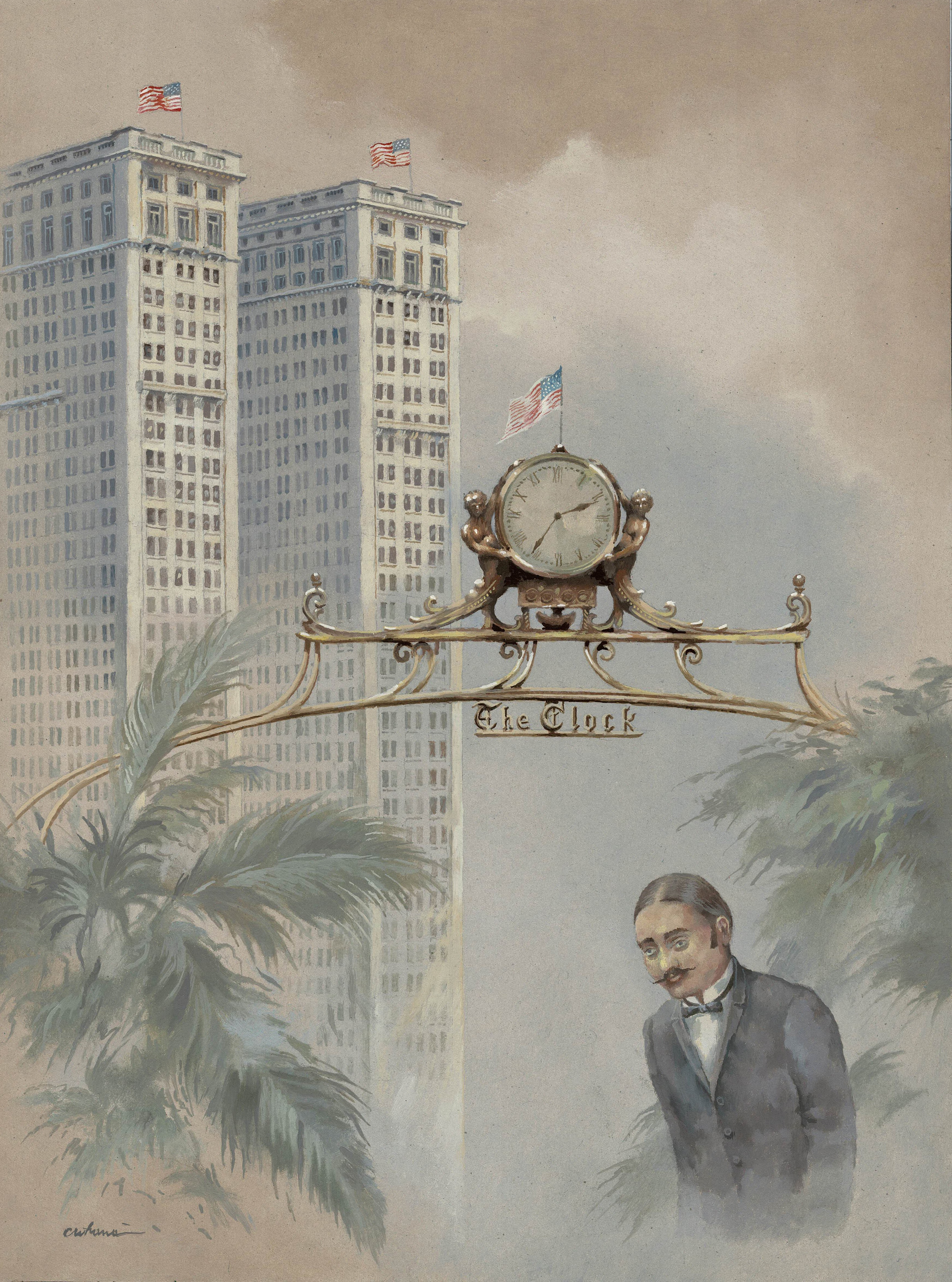
10. The Biltmore Hotel Clock in Palmcourt (in administration by Artios Gallery, New York)
The building was demolished in 1981 despite its “landmark” status and street protests. The hotel had a clock at the reception in Palmcourt under which various meetings were held. The place had become famous. Hence the expression in the USA: “We meet under the clock!”. It also remained famous for its direct connection to Grand Central Station, with its own arrival station. After the demolition of the building, the clock was set in the lobby of the new building.
.

11. Decoration of Flatiron Building (in administration by Artios Gallery, New York)
Harry S. Black hired architect Daniel Burnham to design the new building. In a romantic way, Black accepted the decoration of the building with beautiful bas-reliefs at a height that no one sees! This is the subject of my slightly satirical painting. The exterior decorations are especially beautiful. I found in old documents the expression: “Renaissance palazzo with Beaux-Arts”. The Flatiron Building was the most criticized skyscraper in New York. All the press published articles referring to its triangular section and the fear of collapsing. Today, Flatiron is one of the city’s major attractions. He has been the subject of paintings, films, photographs and postcards. It was the first building built on metal structure in New York. Hence the name “metal block”, flat-iron.
.

12. Chelsea Piers
The chimneys of the ships turn one by one into skyscrapers, a sign that anyone arriving in New York must adapt to the specific American life. Chelsea Piers are a series of luxury maritime terminals built on pillars in Chelsea, in the west of Manhattan. Located west of the West Side (Eleventh Avenue) and Hudson River Park and east of the Hudson River, they were originally just a passenger ship terminal in the early 1900s, which was used by RMS Lusitania and was the destination of the ship RMS Carpathia after rescuing survivors from RMS Titanic. Pylons have replaced a variety of dilapidated waterfront structures with a row of grand buildings embellished with pink granite facades.
.

13. Gardens of the Nations
The Garden of Nations is on the 11th floor of the main building of the Rockefeller complex. Architect Ralph Hancock took care of the garden arrangements between 1933-1935, including various plants, tulips, trees, stone, waterfalls. The countries represented were the Netherlands, France, Japan, Italy and Spain. The inauguration was done with great speed. Water and energy consumption was great; In 1938 the garden became unprofitable and closed. The image is represented by a blooming tree. But in my painting I wanted to highlight another aspect, namely: the entire Rockefeller complex was built on the site of a former botanical garden – Elgin Gardens. She is represented in the image by Sera Elgin, which I placed in Central Park.
.

14. Empire State Building Observatory Desk
A financial study shows that the money earned from the observer’s visitor tickets exceeds the rent earnings from all the rooms in the building. The ticket is marked as a “souvenir” to cherish it properly. But there is nothing to see between the ground floor and the last floors. It runs with elevators situated in the center of the building. Observatory Deck is a reward for those who are content with a general look at Manhattan.
.

15. Walking in Row Park
19th-century journalism took place in the most imposing buildings in New York. The buildings were concentrated in Park Row, where the mayor’s office was. The three major newspapers had their headquarters here: The New York Times, The New York Tribune and The New York World. The New York World Building has been for many years the tallest building in the world.
.

16. Scene at Flatiron Building
A legend has already been born about the whirlwinds and the strong current around the building – the most powerful in the city, according to some historians. The wind lifted the girls’ dresses, and the youngsters stood lurking to admire the scenery. A policeman came up beside the building to expel these naughty ones. It was here that the American expression “23 skidoo” was born first by police officers. “23” comes from the street name: 23rd Street (Manhattan).
.

17. Work in Progress on Fifth Avenue
Two surprising appearances in my studies: the vehicle that could make a city tour and the traffic control tower. The vehicle – looking like an amphibian – was leaving in front of the Flatiron building. It was actually a trolley without a roof, with benches, driven by a driver. The tower could be seen and studied in old photographs taken on Fifth Avenue near the New York Public Library. It was small at the base to leave the traffic, and the top was a cabin with beautiful exterior decorations. It had three bright lights arranged horizontally and it seems to me that the “traffic light” appeared with green, yellow and red.
.

18. Ed Koch Queensboro Bridge – the Market
From the story of the construction of the bridge and the surrounding area, I chose to capture three things: the form of the “ugly” bridge seen from the shore, the funicular and the Food Emporium market. The work can become one of my favorite pieces of the series. It is a combination of the American technical effort and maybe the Wild West, represented here by the farmers’ wagons.
.

19. Chelsea Piers of Zeppelins
It was envisioned that the top of the Empire State Building would become a zeppelin station. The idea fell through and I thought of giving the city berths for the zeppelins left in the air. It was in this area on the Hudson River that the Titanic was supposed to arrive in April 1912.
.

20. New York Times Building
The New York Times settled in this building coming from Park Row, near the Town Hall. The building dominates Times Square. It is a triangular building in two levels. It looks like Flatiron Building. It was particularly beautiful with spectacular decorations. Today it is completely covered with glass and bright advertising. The interior is no longer inhabited. The famous newspaper gave the name to the building (Times Tower) and to the market (Times Square).
.

21. Stunning Performance at Grand Theater
It was a Jewish contribution to the New York culture. The façade had many neoclassical motifs, but to the limit of good taste. The representations were amateur and were severely criticized and ironized in the press. The only professional was an old actor. The audience was in fact entertained by the actors’ blunder. At the end of a show, the heavy curtain fell over an actor, putting him on the floor (The Sun). Today, if it existed, the theater would have been in Chinatown.
.

22. Chrysler Building Entrance in Central Park
Chrysler building entrance crossing Central Park. It was the time of the Great Depression when huge constructions were erected in New York; they remained in the history of the city. The park was home to homeless people, forming “Hoover Village” after the president at the time.
.

23. The Return Way of Elephants on Brooklyn Bridge
The endurance test of the Brooklyn Bridge was done with a group of circus elephants from Barnum’s troupe, led by the famous Jumbo. I carefully followed the route in the documents and found out the direction in which the elephants crossed the bridge. They started from Manhattan. I couldn’t find anywhere if they went all the way back to the bridge or stayed in Brooklyn. There were 21 elephants, 7 camels and 10 dromedaries.
.
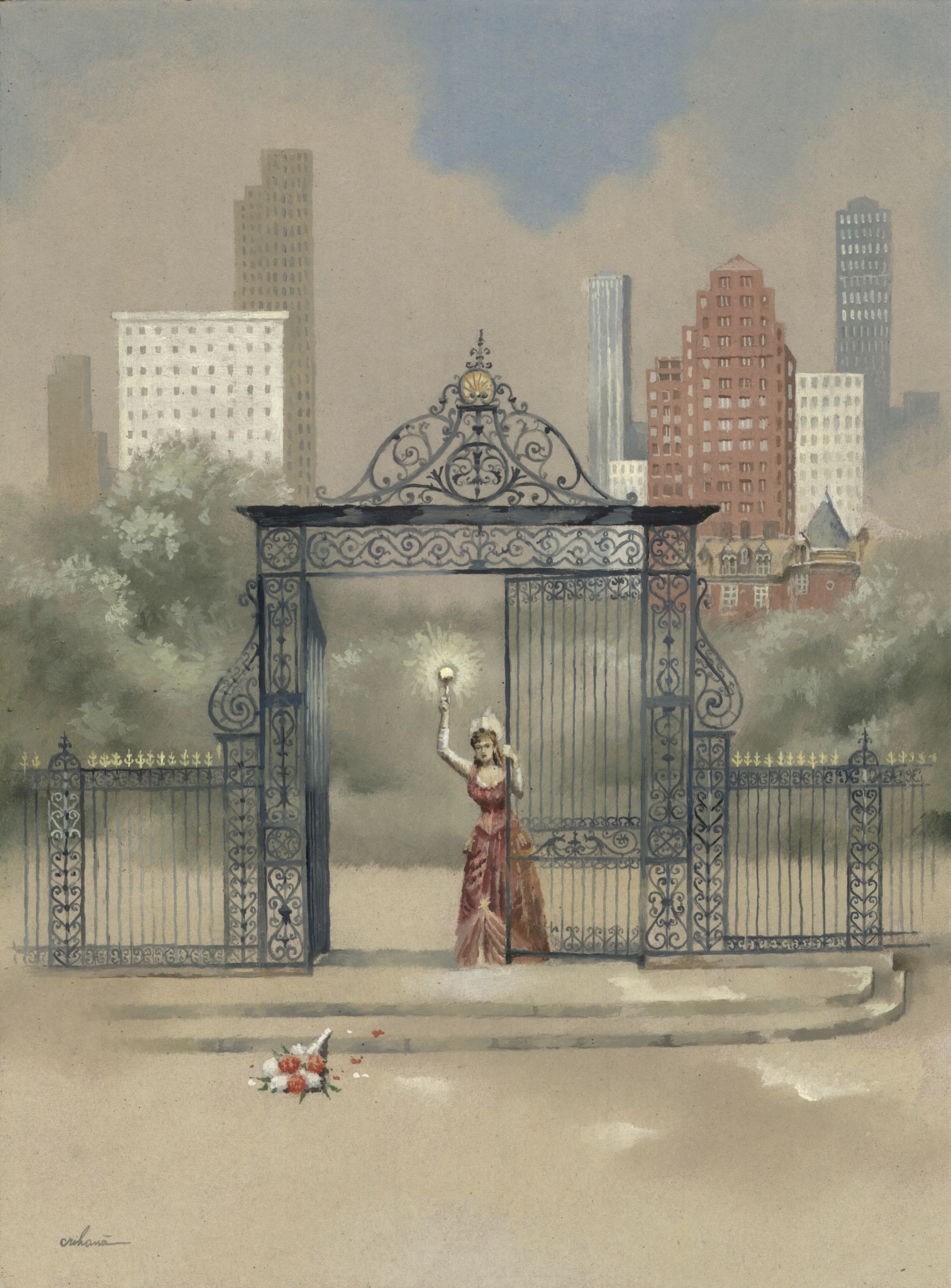
24. Vanderbilt Gate of Central Park
It’s a place where married young people are making photo sessions today. But what is the past of this gates? It comes from an old house that “The New York Times” wrote as “the nicest living space in America.” The castle was demolished only 40 years after its construction, because after the disappearance of the Vanderbilt clan, there was no one to take over. Alice Vanderbilt was the last person in the family to administer the home. She has remained in New York City’s history to host the most famous ball of dresses, her costume entitled “Electric Light” – an allusion to Thomas Edison’s discovery.
.

25. Central Synagogue (currently involved in an event)
The Synagogue is an architectural monument – landmark. It was built in 1870-1872 after a model in Budapest. During its construction, its monumentality has engendered envy, which damages the phenomenon of assimilation. The Moorish style was nevertheless accepted. It has two octagonal towers, meaning the remnants of the Temple of Solomon. They end with two copper cups in the shape of onions.
.
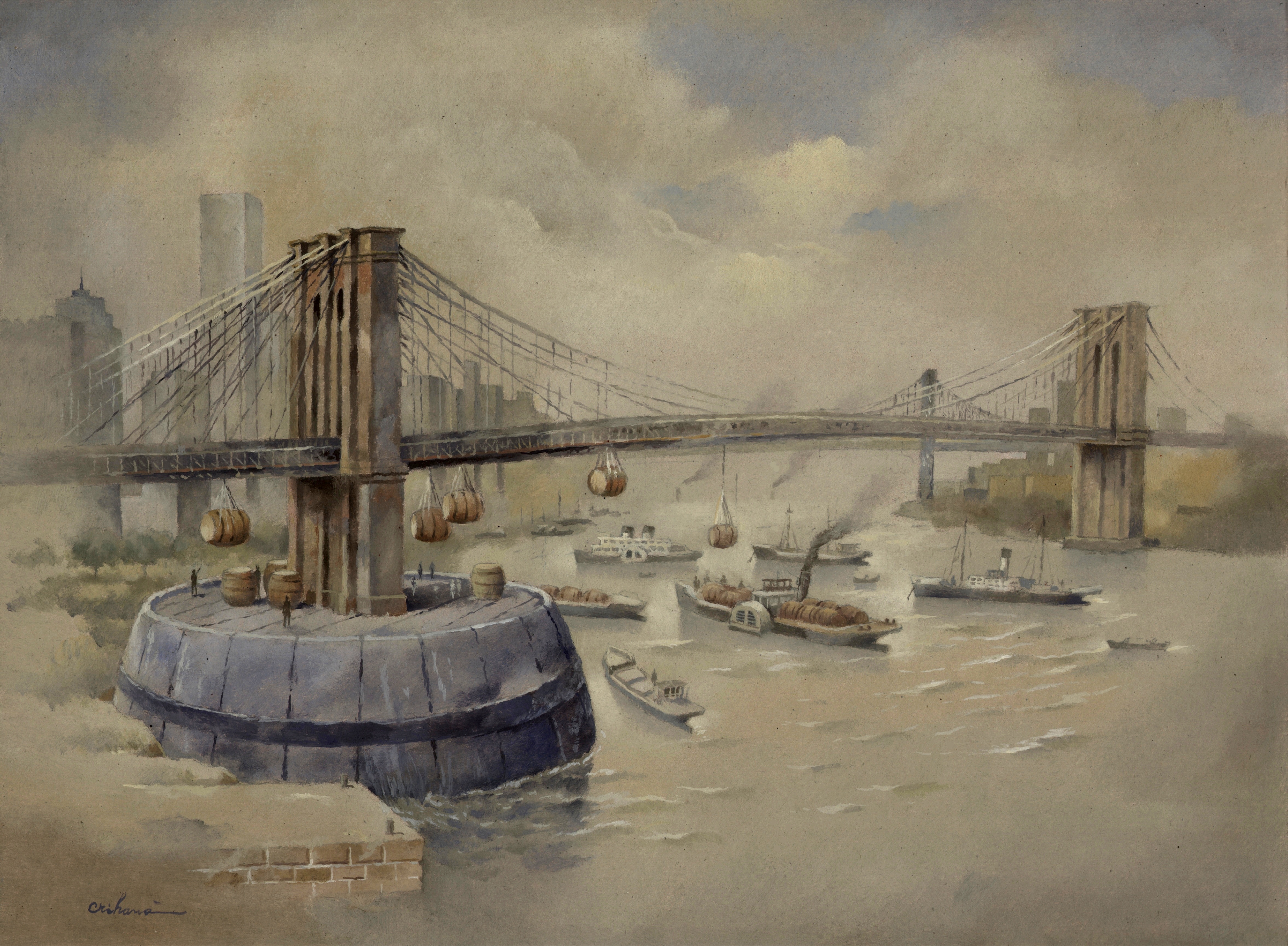
26. Blue Grotto – Brooklyn Bridge
Ever since the construction of the bridge (1876), the New York City Hall rented the pillars of support to raise funds. The Manhattan pillar was used as a wine warehouse. It was named Blue Grotto due to the color of Mary’s vestibule from an altar at the entrance to the pillar. Storage temperature was constant at 16 ° C.
.

27. Walter and Della Viola Chrysler
Walter Chrysler was born in 1875. He ran several companies throughout his career: American Locomotive Co., Buick Motor, Willys Overland and Maxwell. It produced the Plymouth, De Soto and Chrysler automobiles. The Chrysler Building he erected for his children. At only 56 years old, he retires from activity. Unfortunately his wife, Della Viola dies after two years. Walter suffered a shock, from which he never recovered. He was named Man of the Year in 1928 by Time Magazine.
.

28. Mount Sinai Hospital
The story of Mount Sinai Hospital is representative of dramatic architectural changes in New York – the last 150 years. During this time, the hospital was in turn in four buildings, two of which were on Lexington Street, represented in painting. I studied this institution as a sign of respect for the remarkable scientific discoveries made by medical staff in the 170 years since their establishment. Today the hospital is in a huge building on Fifth Avenue facing Central Park.
.

29. Penn Entrance in US
The image shows the ocean ward end of Low Manhattan, or vice versa—the first area of American land seen by those arriving from the ocean. Symbolically, in admiration of the past, they can enter the United States through the Chelsea terminals, disembarking through a structure taken over from Penn Station.
.
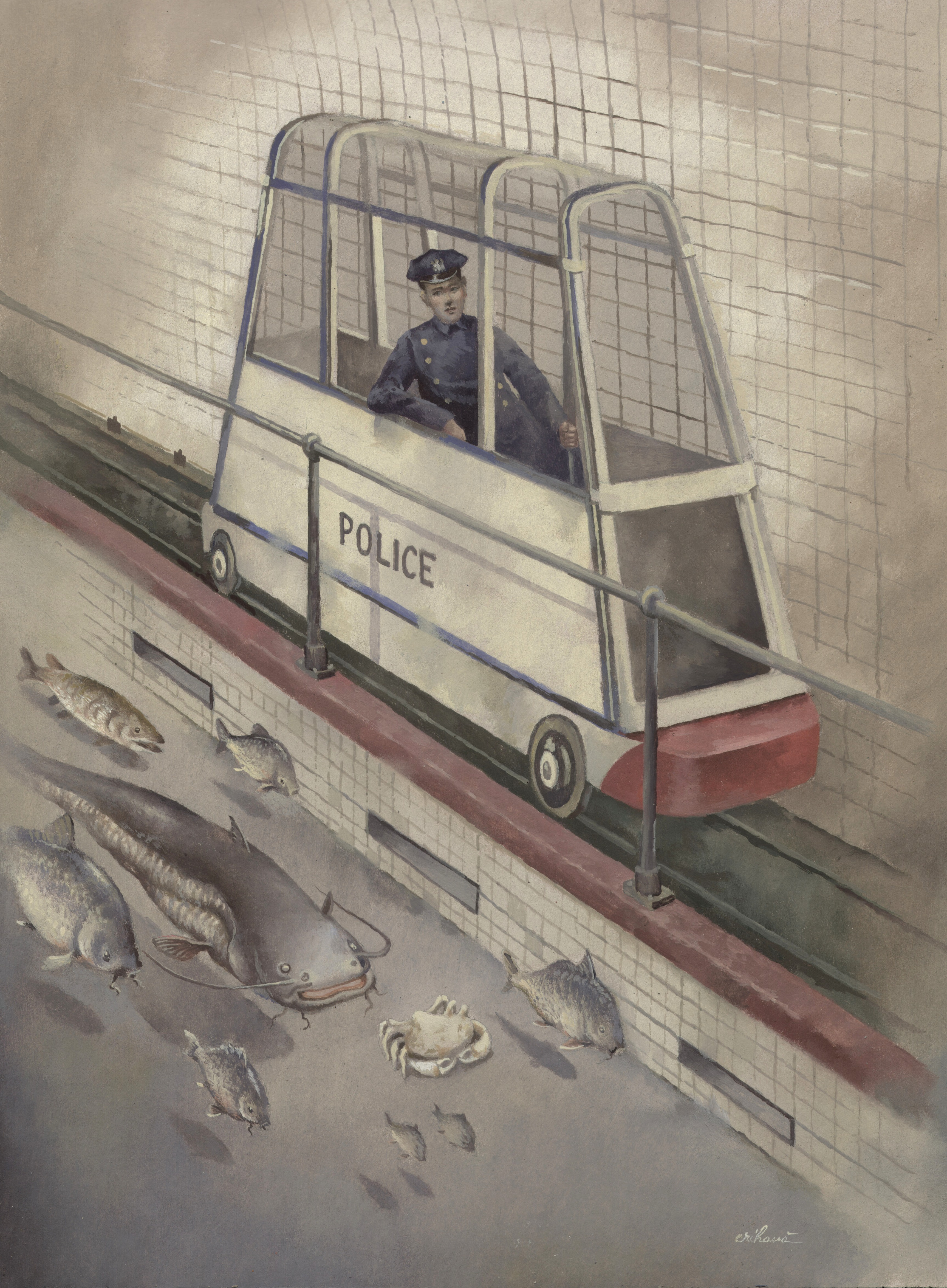
30. Holland Tunnel Traffic Controller
The Holland Road Tunnel was built between 1920 and 1927 under the Hudson River and connected Manhattan to New Jersey. The option of using a bridge was excluded, due to the great width of the river. Thus, the tunnel also raised problems due to its length, including traffic coordination. The Americans invented a narrow cabin “Catwalk”, in which the traffic agent could move without problems along the tunnel at the critical points. It was an electric vehicle that ran on rails. The model was also used in the Lincoln Tunnel.
.
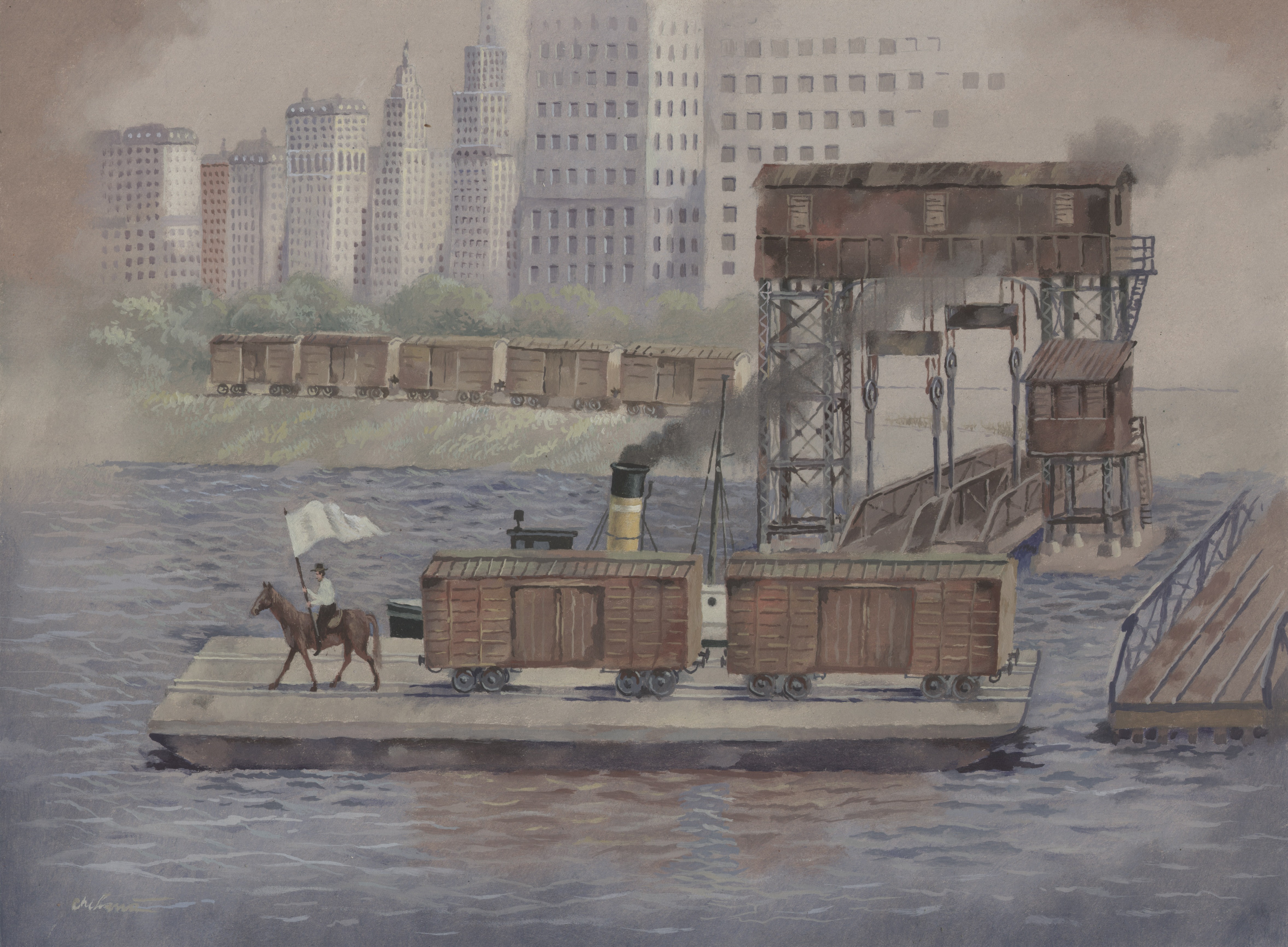
31. 69th Street Transfer Bridge – Hudson River
If Manhattan’s connection with Brooklyn was solved by some bridges, the one with New Jersey was a big problem. The Hudson River, much wider than the East River, led to the idea of ferry, and later tunnels were built. A known crossing point was “69th Street Transfer Bridge”. It was the terminal that took over the West Side Manhattan railway wagons. The sides of the plant kept the wagons from falling into the water. The construction was innovative and worked well for decades. And today there are some relics of the machine. By spreading the press, we also found a mischievous article in the New York Times. An old man living in Trump Square is quoted as saying: “The machine is a garbage, and it must be removed!”. But this garbage showed me how things worked in the past in New York, becoming able to get a more complete picture of the city’s freight.
.

32. Miss Brooklyn and Miss Manhattan
At the end of the nineteenth century, the connection between Manhattan and Brooklyn was made on the two existing bridges across the East River. They were considered as gateways for the massive flow from Manhattan overpopulation to the Brooklyn underdeveloped. Here is why the new bridge was built: “Bridge Number 3”. Brooklyn Bridge traffic has become unbearable and very dangerous for the population and the stability of the bridge. Therefore some of the public transport functions have been stopped. Between 1900 and 1909 several mayors have changed to lead the city, and several architects have come up with bridge projects. The one who has puzzled was the Municipal Commission for Art. It was a group of highly influential officials. Initially, hybrid projects were proposed that brought details from the other two existing bridges, referring to the suspension system at the bridge and at the foot of the bridge. Eventually, Leon Moisseff’s project, which came with a modern concept – a new vision of the cable suspension system, was approved.
.

33. Williamsburg Bridge and Low Line Project
The Williamsburg Bridge is a suspension bridge in New York City over the East River that connects the eastern side of Manhattan at Delancey Street with the Williamsburg neighborhood of Brooklyn at Broadway near the Brooklyn-Queens Expressway (Interstate 278). Completed in 1903, it was the longest stretch of suspension bridge in the world until 1924. At the “landing” of the bridge in Williamsburg, there was a huge depot underground, the place where certain streetcar routes returned. For several decades the place remained abandoned, degraded. Solutions were sought for setting up an underground greenhouse, the difficult part being the capture of sunlight. A technical solution came recently through the invention of a parabolic mirror, which deflects the sun’s rays underground.
.

34. Tribute to New York
The painting shows a simplified view of Manhattan with the two towers in the center but also pairs of Moses stone tablets with flowers.
.

35. Journalist in Times Square
The painting shows the old headquarters of The New York Times, as it looked until 1913 when it moved. In the foreground is a journalist who has already detached himself from the newspaper headquarters.
.

36. Five and Ten Cents (Private Collection)
The building was built in the period 1910-1912 at the request of Frank Winfield Woolworth – American investor, the one who founded the five-and-ten-cent concept. The building was the headquarters of his company. The architecture is neo-Gothic with European inspiration. From the series of coins made over time, I chose the most famous ones.
.

37. Rows of Colonades
In 1885 it was felt that the City Hall needed more space. Offices were already operating in locations scattered across the city. They were very expensive. A project by McKim, Mead&White was accepted. The ground floor has a belt of columns on the outside that I extended to the Brooklyn Bridge Terminal.
.

38. Newspaper Row
This is a picture of the Brooklyn Bridge terminal area as it was a long time ago. Park Row Avenue is made as a printing press of the newspapers that were based in the area – The New York Times, The New York Tribune and The New York World.
.

39. Soldier Monument
“November 11th commemorates the end of World War I and is a date on which we honor all U.S. veterans who have served and are serving in our country’s military. A walk through Trinity and St. Paul’s churchyards would remind you that many of our country’s earliest veterans are interred right in our parish’s lower Manhattan burial grounds.
Perhaps the largest monument in either churchyard is the Soldiers’ Monument which stands in the Northeast corner of Trinity churchyard and memorializes the many soldiers who died while imprisoned on prison ships docked around the city throughout the revolutionary war.” trinitywallstreet.org


A reamacable recovery by art, of the buidings that have been famous some time ago, and theyr story!
LikeLike
Thank you so much!
LikeLike